Festo DHRC-16-A Handleiding
Festo
Niet gecategoriseerd
DHRC-16-A
Bekijk gratis de handleiding van Festo DHRC-16-A (3 pagina’s), behorend tot de categorie Niet gecategoriseerd. Deze gids werd als nuttig beoordeeld door 2 mensen en kreeg gemiddeld 4.8 sterren uit 1.5 reviews. Heb je een vraag over Festo DHRC-16-A of wil je andere gebruikers van dit product iets vragen? Stel een vraag
Pagina 1/3

DHRC
Radial gripper
Festo SE & Co. KG
Ruiter Straße 82
73734 Esslingen
Deutschland
+49 711 347-0
www.festo.com
Operating instructions
8159517
2021-12
[8159519]
Translation of the original instructions
© 2022 all rights reserved to Festo SE & Co. KG
1
Applicable Documents
All available documents for the product
è
www.festo.com/sp.
2 Safety
2.1 Safety instructions
–
Only use the product in its original condition without unauthorised modifica-
tions.
–
Take into account the ambient conditions at the location of use.
–
Only use the product if it is in perfect technical condition.
–Store the product in a cool, dry environment protected from UV and corrosion.
Keep storage times short.
–Before working on the product, switch off the compressed air supply and lock it
to prevent it from being switched on again.
2.2 Intended use
The intended use of the product is to grip and hold payloads (workpieces) using
custom-designed gripper fingers attached by the customer.
2.3 Training of qualified personnel
Work on the product may only be carried out by qualified personnel who can
evaluate the work and detect dangers. The qualified personnel have knowledge
and experience in dealing with pneumatic drives and pneumatic axes.
3
Additional information
–Contact the regional Festo contact if you have technical problems
è
www.festo.com.
–Accessories and spare parts
è
www.festo.com/catalogue.
4
Function
–Alternating pressurisation of the supply ports moves a piston in the gripper.
This results in a double-acting function.
–A gripper with integrated spring return is used to exert the gripper force. When
exhausting the single-acting gripper: the spring return moves the gripper jaws
to the initial position.
–N/O contact: NO normally open
–
N/C contact: NC normally closed
–The piston movement is transmitted mechanically to the gripper jaws. Gripper
fingers are attached to the gripper jaws. Closing or opening the gripper fingers
clamps the payload by the outer contour or the inner contour.
–
The gripping force is adjusted by external regulation of the operating pressure.
–The gripper has integrated fixed flow restrictors. If the maximum gripper finger
weights and the maximum gripper finger lengths are in compliance, external
flow control is not required.
5 Product design
1
2
3
4
5
Fig. 1: Product design
1
Gripper jaw
2
Threaded hole for mounting
3
Locating hole
4
Supply port
5
Slot for proximity switch
6 Assembly
6.1
Preparing the gripper fingers
The gripper fingers are not included in the delivery.
Requirements for the gripper fingers
è
12 Technical data:
–Observe the maximum permissible forces and maximum permissible torques at
the gripper jaw.
–
Observe the maximum length and weight.
–Use gripper fingers that are as short and light as possible.
–
Manufacture gripper fingers that are suitable for the payload and type of grip-
ping action.
DHRC -6 -10 -16 -20 -25 -32
Width at gripper jaws [mm] 2.2 3 4.4 5.6 6.6 8.6
Tab. 1:
Width of gripper jaws
6.2
Mounting gripper finger
2
1
3
Fig. 2:
Mounting gripper finger
1
Gripper finger
2
Screw
3
Gripper jaw
• Position the prepared gripper fingers [1] on the gripper jaws [3] and secure
with two screws [2] on each. Fix the gripper jaws in place during mounting and
use the specified tightening torque.
DHRC -6 -10 -16 -20 -25 -32
Screw – – M4 M5 M6
Drilled hole 2.2 3.2 – – –Æ Æ
Locating hole for centring pin [mm] – 2 + 0.02 3 + 0.02Æ Æ
Tightening torque [Nm] 0.4 1.2 2.1 2.8 4.8 8.6
Tab. 2:
Dimensions and tightening torque

6.3 Mounting gripper
If necessary, mount the proximity switches before mounting the gripper.
When using proximity switches for sensing the end position, take the following
into account:
• Interference from ferritic attachments, e.g. retaining screws made of ferritic
steel.
• Projecting proximity switches, if applicable.
• Cable outlet direction of the proximity switches.
• Sufficient space for the connection components.
• When sensing from both end positions: use separate slots for the proximity
switches.
Vertical mounting
1
2
Fig. 3: Direct fastening via thread in the
housing
1
Thread
2
Locating hole
DHRC -6 -10 -16 -20 -25 -32
Thread [1] M3 M4 M5 M6
Thread depth [mm] 10 4.75 6.75 8.67 13 15
Tightening torque [Nm] 0.88 0.68 2.5 4.3 7.8 10
Locating hole for centring pin
[2]
[mm] – 2Æ
H9
Æ 3
H9
Æ 4
H9
Æ 5
H9
Depth of locating hole [mm] – 3 4 5
Tab. 3: Direct fastening via thread on the housing
1 2 3
Fig. 4: Direct fastening via through-
hole
1
Thread
2
Locating hole
3
Depth of locating hole
DHRC -6 -10 -16 -20 -25 -32
Thread [1] M2.5 M2.5 M3 M4 M5 M5
Tightening torque [Nm] 0.5 0.5 0.88 2.1 4.3 4.3
Locating hole for centring pin
[2]
[mm] – 2Æ
H9
Æ 3
H9
Æ 4
H9
Æ 5
H9
Depth of locating hole [3] [mm] – 3 4 5
Tab. 4: Direct fastening via through-hole
Horizontal mounting
1
2
Fig. 5:
Horizontal mounting
1
Locating hole
2
Thread
DHRC -6 -10 -16 -20 -25 -32
Thread [2] – M3 M4 M5 M6
Thread depth [mm] – 4 4.5 8 10
Tightening torque [Nm] – 0.8 1.6 3.3 5.8 5.8
Locating hole for centring pin
[1]
[mm] – 2Æ
H9
Æ 3
H9
Æ 4
H9
Æ 5
H9
Depth of locating hole [mm] – 3 4 5
Tab. 5:
Horizontal mounting
Mounting on the bottom
1 32
Fig. 6: Mounting on the bottom
1
Thread
2
Locating hole
3
Positioning via base provided by
customer
DHRC -6 -10 -16 -20 -25 -32
Thread – M3 M4 M5 M6
Thread depth [mm] – 4 6 10 12 13
Tightening torque [Nm] – 0.88 2.1 4.3 7.3 7.8
Locating hole for centring pin [mm] – 2Æ
H9
Æ 3
H9
Æ 4
H9
Æ 5
H9
Depth of locating hole [mm] – 3 4 5
Positioning via base provided by customer
Locating hole [mm] 8Æ
H8
Æ 12
H8
Æ 17
H8
Æ 21
H8
Æ 26
H8
Æ 25
H8
Depth of locating hole [mm] 1.5 2
Tab. 6: Mounting on the bottom
7
Pneumatic installation
NOTICE
Loss of function due to contamination in the connections.
• Keep ports and tubing lines free from dirt particles and foreign matter.
The use of a check valve prevents the payload from dropping in the event of
a sudden pressure drop. The use of a one-way flow control valve also permits
adjustment of the opening and closing times.
Fig. 7:
Connection options
•
Connect the compressed air supply to the supply port.

8 Commissioning
WARNING
Risk of injury due to falling loads.
• Before exhausting remove the payload.
1.
Slowly pressurise gripper.
2.
Set the opening and closing times with an upstream one-way flow control
valve: screw in the flow control screw completely and then unscrew it one
turn.
3. Perform a test run without payload.
Check the following:
–Allocation of the supply ports
–The reliable function of the proximity switches (if installed)
–The stop noise of the piston: the piston stop must be soft, that means not
audibly hard or metallic.
Piston stop Insight/conclusion
soft The gripper speed is correct or can be increased. With an
upstream one-way flow control valve: unscrew the flow control
screw a little the gripper speed increases.è
hard/metallic The gripper speed is too high. With an upstream one-way flow
control valve: screw in the flow control screw until the piston
stop is no longer audibly hard or metallic the gripper speedè
is reduced.
4.
Perform a test run with payload.
Ä
The gripper must hold the payload securely.
5.
After successful test runs:
–
Remove the payload or lock to prevent it from falling.
–Exhaust the gripper.
9 Maintenance
9.1 Safety
WARNING
Risk of injury due to unexpected movement of the gripper fingers or falling
payload.
• Before exhausting: remove the payload at the gripper.
•
Disconnect gripper from the compressed air supply.
9.2 Clean product
•
Clean the outside of the product with a soft cloth as required. Cleaning agents
include all non-abrasive media.
10 Fault clearance
Error description Cause Remedy
The gripper does not hold the
payload securely.
The operating pressure is too
low.
Increase the operating pres-
sure. Observe the max. permis-
sible value.
The pressure point of the
gripper fingers is too far out-
wards.
Move the pressure point
inwards.
The payload is too heavy. Select a larger gripper.
Gripping only with return spring
force with incorrect gripping
direction.
Use the specified gripping
direction.
The gripper does not open/
close.
No compressed air. Check the supply ports.
The gripper is faulty. Replace the faulty parts
è
www.festo.com/spareparts.
Replace the gripper.
The proximity switch does not
indicate the gripper status.
The proximity switch is incor-
rectly adjusted.
Check and adjust the posi-
tion of the proximity switch
è
www.festo.com/sp.
The connecting cable is discon-
nected.
Replace the connecting cable
or the proximity switch
è
www.festo.com/sp.
Tab. 7:
Fault clearance
11 Disassembly
WARNING
Risk of injury due to unexpected movement of the gripper fingers or falling
payload.
• Before exhausting: remove the payload at the gripper.
•
Disconnect gripper from the compressed air supply.
1.
Disconnect the gripper from the compressed air supply.
2. Remove the supply ports and retaining screws.
12 Technical data
DHRC -6 -10 -16
Pneumatic port M3 M3 M3
Mounting position any
DHRC -6 -10 -16
Medium
Operating medium Compressed air to ISO 8573-1:2010 [7:4:4]
Notes on the
operating/pilot medium
lubricated operation possible, in which case lubricated
operation will always be required
Temperature
Ambient temperature [°C] –10 … +60
Storage temperature [°C] –10 … +80
Operating pressure
DHRC-...-A [MPa] 0.25 … 0.8 0.1 … 0.8
[bar] 2.5 … 8 1 … 8
[psi] 37 … 116 15 … 116
DHRC-...-AS-NO [MPa] – 0.2 … 0.8
[bar] – 2 … 8
[psi] – 30 … 116
Total gripping force at 0.6 MPa (6 bar; 90 psi)
DHRC-...-A
Open [Nm] 0.067 0.253 0.811
Close [Nm] 0.048 0.204 0.668
DHRC-...-AS-NO
Close [Nm] – 0.158 0.503
Tab. 8:
Technical data
DHRC -20 -25 -32
Pneumatic port M5 M5 M5
Mounting position any
Medium
Operating medium Compressed air to ISO 8573-1:2010 [7:4:4]
Notes on the
operating/pilot medium
lubricated operation possible, in which case lubricated
operation will always be required
Temperature
Ambient temperature [°C] –10 … +60
Storage temperature [°C] –10 … +80
Operating pressure
DHRC-...-A [MPa] 0.1 … 0.8
[bar] 1 … 8
[psi] 15 … 116
DHRC-...-AS-NO [MPa] 0.15 … 0.8
[bar] 1.5 … 8
[psi] 22 … 116
Total gripping force at 0.6 MPa (6 bar; 90 psi)
DHRC-...-A
Open [Nm] 1.662 3.436 7.256
Close [Nm] 1.343 2.775 6.001
DHRC-...-AS-NO
Close [Nm] 1.120 2.395 5.391
Tab. 9:
Technical data
Product specificaties
| Merk: | Festo |
| Categorie: | Niet gecategoriseerd |
| Model: | DHRC-16-A |
Heb je hulp nodig?
Als je hulp nodig hebt met Festo DHRC-16-A stel dan hieronder een vraag en andere gebruikers zullen je antwoorden
Handleiding Niet gecategoriseerd Festo
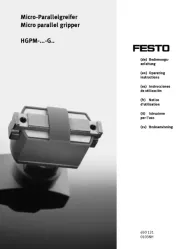
1 Augustus 2025
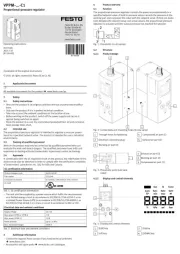
1 Augustus 2025

1 Augustus 2025
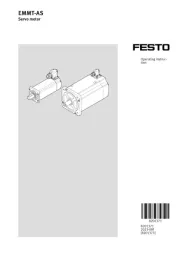
1 Augustus 2025
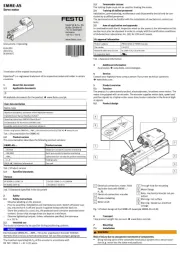
1 Augustus 2025
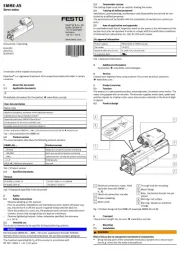
1 Augustus 2025
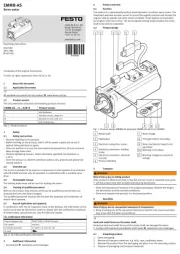
1 Augustus 2025
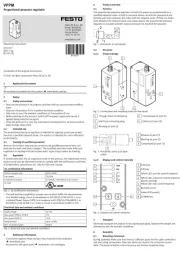
1 Augustus 2025
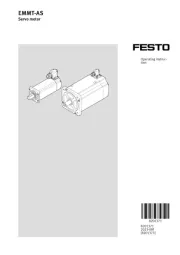
1 Augustus 2025
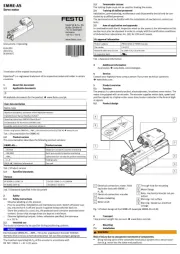
1 Augustus 2025
Handleiding Niet gecategoriseerd
- Mytee
- Mebus
- I-PRO
- Acopa
- Kenmore
- Kipor
- Tanaka
- BikeLogger
- Henry Engineering
- Weidmüller
- Airlive
- DMT
- Powr-Flite
- Autotek
- Wire Technologies
Nieuwste handleidingen voor Niet gecategoriseerd

1 Augustus 2025
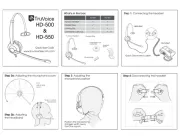
1 Augustus 2025
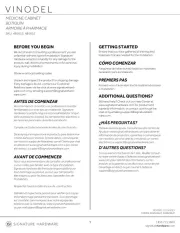
1 Augustus 2025

1 Augustus 2025
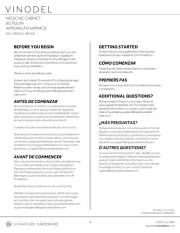
1 Augustus 2025

1 Augustus 2025
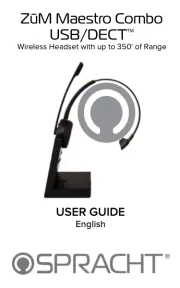
1 Augustus 2025

1 Augustus 2025
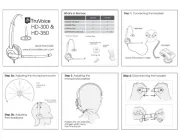
1 Augustus 2025

1 Augustus 2025